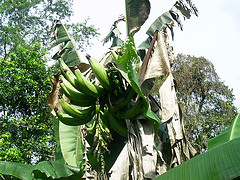Plantains
| Infobox on Plantains | |
|---|---|
| Example of Plantains |  |
| Freshness facts | |
| Optimum carrying temperature | 10°C (green) 11°C to 15,5°C (coloured) |
| Highest freezing point | -0,8°C |
| Acceptable product temp. at loading into containers | Max. 2°C above carrying temperature |
| Optimum humidity | 85% to 90% |
| Ventilation setting for containers | 25 m³/hr |
| Storage life | 5 weeks (green) 1-3 weeks (coloured) |
| Climacteric / non-climacteric | Climacteric |
| Ethylene production | Low |
| Ethylene sensitivity | High |
| Modified / controlled atmosphere | 5-10% CO2% and 2% O2 |
| Potential benefits | CA delays ripening, reduces respiration and ethylene production rates, and maintains overall appearance of the fruit. CA may decrease the occurrence of sub-epidermal browning at marginally low temperatures. |
| Availability | |
| On demand | |
Plantains
Contents
Harvesting and handling
Maturity can be judged by the angularity of the fingers. Plantains are harvested mature-green and may or may not be ripened upon arrival at destination markets since plantains are eaten both at the mature-green stage and when fully yellow. In contrast to dessert bananas, plantains and cooking bananas have a substantial starch content even when fully ripe. In most other respects, the characteristics of bananas and plantains are similar.
Banana and plantain fruits show a climacteric pattern of respiration, and plantains in particular produce substantial quantities of ethylene during ripening. Abrasions result from skin scuffing against other fruit, surfaces of handling equipment, or shipping boxes. When exposed to low relative humidity conditions (<90%), water loss from scuffed areas is accelerated and peel colour turns brown and in severe cases black, which is similar to severe peel browning associated with chilling injury.
Dropping of plantains may induce browning of the flesh with or without damage to the skin. In some cases, damaged areas may become infected with fungal growth.
Cooling and storage
Pre-cooling of (bananas or) plantains is not generally done. Adequate cooling is not initiated until fruit are loaded into containers or cargo holds onboard ships. Because marketing quality standards are more relaxed for plantains (than for bananas), and plantains are more prone to premature ripening during transit and storage, it is recommended that green plantains be held between 8,9°C to 11,7°C.
Plantains grown during the warmer months tend to attain physiological maturity faster than fruit grown during the winter months; consequently green life potential varies during the year. Symptoms of chilling injury include peel browning, dull or smoky peel coloration, sub-epidermal vascular browning, abnormal ripening (possible acceleration); and in severe cases failure to ripen. Chilling injury results from exposure of plantains to temperatures less than or equal to 7.2 ˚C for 7 or more days, depending on cultivar, maturity, and temperature. Chilled fruit are more sensitive to mechanical damage and postharvest decay.
Mixed loads
Ethylene stimulates ripening of plantains. Thus, plantains that are marketed mature-green should be protected from exposure to ethylene.
Cautions
The peel is very sensitive to mechanical damage. Export markets for bananas require a blemish-free fruit, although requirements are a bit more relaxed for plantains. Great care during handling is needed at all times.
Storage disorders
Anthracnose, Crown mould, Chilling injury.











